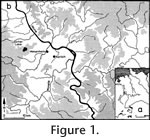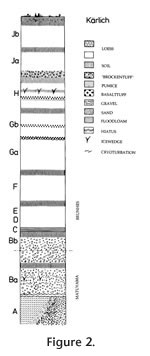|
|
|
Introduction
The complete sequence of Unit Kä F is bound by erosional unconformities. It contains re-deposited gravels and sands, re-deposited loam, re-deposited loess with thin windblown sand layers at the base, real loess with molluscs, re-deposited loess, real loess, and a Bt horizon. A second soil formation, related with the one in the overlying Unit Kä G, is present in the top of Unit Kä F. The boundary between Unit F and G is obscured. Unit Kä G is rather complex; five sedimentary cycles can be observed in the most complete section. The cycles start with a weak erosional phase, followed by the deposition of fluvial deposits with colluvial sediments, and are completed (in cycles 2, 4 and 5) by soil formation at the top. The soils of Kä G cycles 4 and 5 are well developed. Scattered, isolated large mammal remains and artifacts were found in all levels of Unit Kä G. Unit Kä H, between the top of Kä G and the base of a well-developed scoria horizon, the 'Kärlicher Brockentuff,' is complex and can be divided into nine sedimentary cycles. The sediments and the observed ice wedges indicate that deposition of these subunits took place mainly under (early, full, and late) glacial conditions alternated with deposition during interstadial and stadial phases. Evidence of interglacial conditions is present in the upper part of Unit Kä H, just beneath the early glacial colluvial sediments with interglacial molluscs at the top of this unit (Boenigk and Frechen 2001). Paleomagnetic fluctuations are recorded in the lower part of the section. The Matuyama/Brunhes boundary with an age of about 783,000 years is located in Unit Kä Bb (Brunnacker et al. 1976). Reversed paleomagnetic signals, possibly correlative with the Jaramillo event, were recovered from the sediments of Unit Kä A (Boenigk et al. 1974; Brunnacker et al. 1976). Important changes in the heavy-mineral associations also were recognized in the Kärlich sequence (Boenigk and Frechen 2001). Unit G is dominated by brown hornblende, whereas Unit Kä H contains mainly pyroxenes (augite). The hornblende-augite boundary is located in the Dutch Pleistocene sequence at the transition of late Glacial C to Interglacial IV of the "Cromerian Complex." More detailed descriptions of the Kärlich sequence are available in Boenigk and Frechen (2001), Brunnacker (1968, 1971), and Brunnacker et al. (1969). The paleomagnetic data and the heavy mineral associations indicate that the Kärlich main section correlates with the late Early Pleistocene (Kä A and Kä Ba) and the early Middle Pleistocene (Kä Bb - Kä G). The stratigraphic position of Kä H remains unclear. The Quaternary deposits yielded both freshwater and terrestrial molluscs, (Remy and Lozek, in Brunnacker 1971; Roth 1995), paleobotanical remains (pollen and macrofossils) (Urban 1983; Bittmann 1988, 1990), and Palaeolithic artifacts (e.g., Bosinski et al. 1980; Vollbrecht 1994). Several stratified mammalian faunas, within which the Mimomys - Arvicola transition occurs, were collected from the Pleistocene sequence (Kärlich main section - Kä A - Kä H) exposed in the Kärlich pit (van Kolfschoten and Turner 1996). The older faunas Kä C - Kä F are characterized by the presence of Mimomys savini. The oldest representatives of the water vole, Arvicola terrestris cantiana, were recovered in the rich fauna from Kä G. The Kä C fauna includes Microtus gregaloides and represents open environment and continental climatic conditions. The Kä E faunal assemblages is characterized by the occurrence of Dicrostonyx sp., indicative of an open environment and cool, glacial climatic conditions, and Clethrionomys glareolus and Apodemus sp, indicative of a more wooded environment and more temperate conditions. The presence of Dicrostonyx and Spermophilus in the Kä F fauna indicates an open environment, and Dicrostonyx suggests cold climatic conditions. Clethrionomys sp. points to the occurrence of at least locally forested areas. The composition of the Kä G assemblage indicates an environment with bodies of water, forested areas (most probably along the beds of the river), and areas with steppe vegetation outside the river valley. The relatively high percentage of Clethrionomys glareolus, Apodemus sylvaticus and Apodemus cf. maastrichtiensis, and the occurrence of Eliomys quercinus point to interglacial, or at least interstadial, climatic conditions during deposition of Kä G. The faunal record from Kä H is rather poor; the number of fossils remains is low, and the identified species are not very informative. The amphibian and reptiles record from Kärlich is restricted to units Kä E, Kä G, and Kä H. The amphibians and reptiles are listed in Table 1. The stratigraphic and paleoecological conclusions that can be drawn based on their occurrence are also discussed below. |
|

